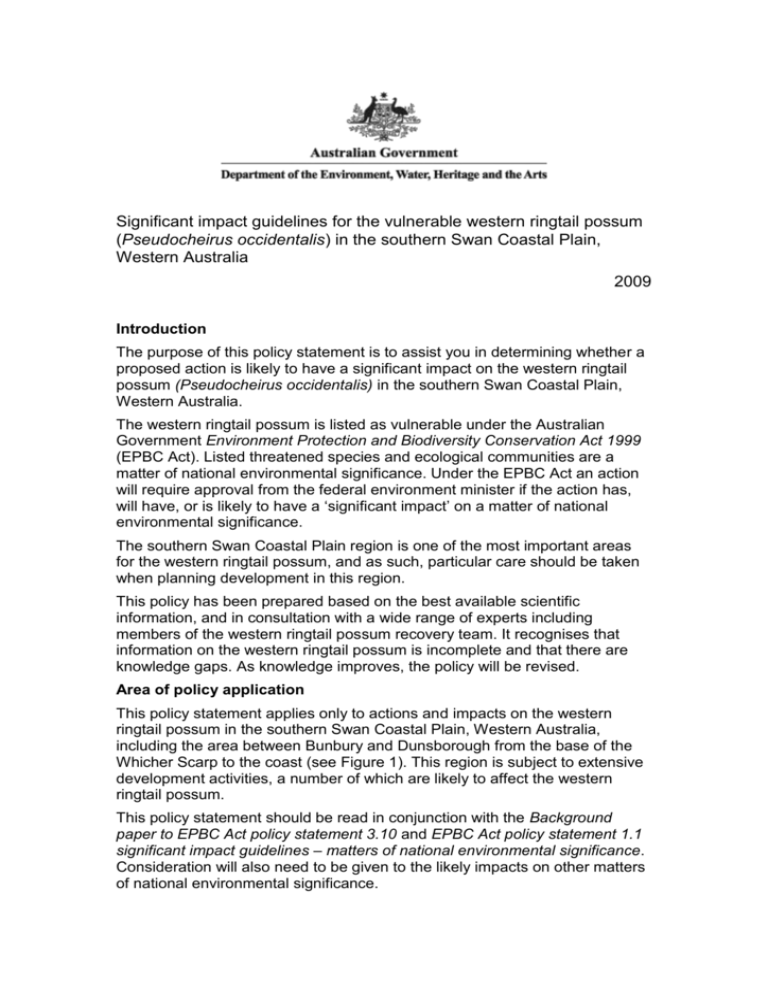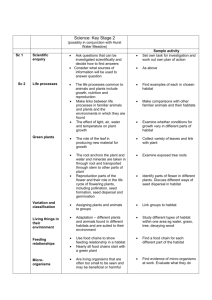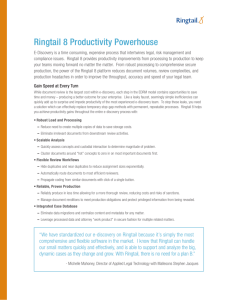
Significant impact guidelines for the vulnerable western ringtail possum
(Pseudocheirus occidentalis) in the southern Swan Coastal Plain,
Western Australia
2009
Introduction
The purpose of this policy statement is to assist you in determining whether a
proposed action is likely to have a significant impact on the western ringtail
possum (Pseudocheirus occidentalis) in the southern Swan Coastal Plain,
Western Australia.
The western ringtail possum is listed as vulnerable under the Australian
Government Environment Protection and Biodiversity Conservation Act 1999
(EPBC Act). Listed threatened species and ecological communities are a
matter of national environmental significance. Under the EPBC Act an action
will require approval from the federal environment minister if the action has,
will have, or is likely to have a ‘significant impact’ on a matter of national
environmental significance.
The southern Swan Coastal Plain region is one of the most important areas
for the western ringtail possum, and as such, particular care should be taken
when planning development in this region.
This policy has been prepared based on the best available scientific
information, and in consultation with a wide range of experts including
members of the western ringtail possum recovery team. It recognises that
information on the western ringtail possum is incomplete and that there are
knowledge gaps. As knowledge improves, the policy will be revised.
Area of policy application
This policy statement applies only to actions and impacts on the western
ringtail possum in the southern Swan Coastal Plain, Western Australia,
including the area between Bunbury and Dunsborough from the base of the
Whicher Scarp to the coast (see Figure 1). This region is subject to extensive
development activities, a number of which are likely to affect the western
ringtail possum.
This policy statement should be read in conjunction with the Background
paper to EPBC Act policy statement 3.10 and EPBC Act policy statement 1.1
significant impact guidelines – matters of national environmental significance.
Consideration will also need to be given to the likely impacts on other matters
of national environmental significance.
What other laws protect the western ringtail possum?
The western ringtail possum is also listed as ‘fauna that is rare or likely to
become extinct’ under the Western Australian Wildlife Conservation Act 1950
(Wildlife Conservation (Specially Protected Fauna) Notice 2006). If your
activity could affect the species or individual animals you should contact the
relevant State and local authorities regarding your obligations.
Background: The western ringtail possum
The western ringtail possum is a medium-sized marsupial weighing up to 1.3
kg and 40 cm in body length. The fur is dark brown above with cream to grey
fur underneath. The tail grows to 41 cm long and terminates in a white tip.
Once widely distributed across southern and south western Western
Australia, the western ringtail possum now occurs only in south western
Western Australia and its distribution is patchy. The species is most
commonly recorded in coastal or near coastal forest that includes peppermint
(Agonis flexuosa) trees as a major component.
There have been extensive local declines in the northern and inland parts of
the original range of the species. Much of the former habitat of the species
was cleared or fragmented during the agricultural development of southwestern Western Australia. This original habitat loss, coupled with ongoing
loss and degradation of habitat and other threatening processes, has
contributed to a restriction of the species range. Currently, the overall
population trend for the species is declining.
Why is the southern Swan Coastal Plain important for the western
ringtail Possum?
The southern Swan Coastal Plain is considered to be important for the
western ringtail possum because it has a number of unique characteristics,
including:
the highest known density populations
dense and productive peppermint habitat, and
habitat where the brushtail possum (Trichosurus vulpecula) does not cooccur with the western ringtail possum and therefore doesn’t compete with
it for resources.
The area also supports the largest known population of the western ringtail
possum, with the greatest potential to provide recruits to adjacent areas. This
population may form a critical resource for survival of the species. These
unique characteristics of the southern Swan Coastal Plain make it essential to
preserve the key functions of local habitat to support the long term recovery of
the species.
Additional information on the western ringtail possum, its habitat and ecology
can be found in the accompanying background paper. The background paper
should be read in conjunction with this policy statement.
What is the Australian Government trying to achieve for the western
ringtail possum?
The Australian Government’s goal is to achieve the recovery of the western
ringtail possum by ensuring that the species is self-sustaining and no longer
threatened.
The southern Swan Coastal Plain is under high development pressure,
including in some areas containing prime habitat for the western ringtail
possum. The aim of this policy is to prevent significant impacts on the possum
and its habitat in the southern Swan Coastal Plain and ensure the region
contributes to the continued functioning of the possum population by:
protecting key remnant habitat patches
ensuring the possum can persist in the Busselton
urban area expanding habitat, and
maintaining or creating habitat connections that allow strong movement of
individuals (in order to maintain genetic representation between local
populations).
Three different areas of habitat within the southern Swan Coastal Plain have
been identified as necessary for the persistence and recovery of the western
ringtail possum. The location of these habitat areas is indicated in Figure 1.
Area 1 – Core habitat
maintain and enhance the value of existing habitat, particularly for
breeding.
Area 2 – Primary corridors
provide connectivity between areas of core habitat, improving
opportunities for dispersal. Over time, the objective is to consolidate the
existing habitat in this area and build additional high quality habitat to
replace that lost from Area 1.
Area 3 – Supporting habitat
improve habitat quality and connectivity on the plains and to the hinterland,
thus increasing opportunities for foraging, breeding and dispersal.
It is acknowledged that in the case of Busselton, the existing planning scheme
has allowed for significant change in urban form and density. This policy does
not intend to stop development within these areas, but aims to minimise the
loss of habitat. Where habitat loss is unavoidable, the aim is to retain as much
ecological value as possible and replace the lost value in a manner that
contributes to the conservation and future recovery of the species. Any
replacement needs to be timely, be of suitable scale and quality and be in an
ecologically relevant location.
What does this mean for actions in western ringtail possum habitat?
If you think that your action is likely to have a significant impact on the
Western Ringtail Possum (or if you are unsure) you should refer the action to
the Minister for the Environment before commencing the action. The Minister
will make a decision within 20 business days on whether approval is required
under the EPBC Act. Substantial penalties apply for taking an action that has,
will have or is likely to have a significant impact without approval. More
information on referral and assessment can be found at
http://www.environment.gov.au/epbc/assessments/process.html.
What sorts of actions are likely to have a significant impact on the
western ringtail possum?
Whether or not an action is likely to have a significant impact depends on the
sensitivity, value and quality of the environment which is being impacted and
upon the intensity, duration, magnitude and geographic extent of the impacts.
The potential for an action to have a significant impact will therefore vary from
site to site. Having had regard to the available information and consultations
with experts in the field, the Department of the Environment, Water, Heritage
and the Arts is of the view that the following criteria are a reasonable basis to
judge the likelihood of a significant impact. However, actions always need to
be assessed on a case by case basis with consideration for the context of the
action, impact and the environment.
Significant impact thresholds
There is a real chance or possibility of a significant impact on the species if
the action will result in one or more of the following:
Area 1 – Core habitat
clearing in a remnant habitat patch that is greater than 0.5 hectares in size
clearing of more than 50% of a remnant habitat patch that is between 0.1
and 0.5 hectares in size, or
fragmentation of existing habitat linkages.
Area 2 – Primary corridors
clearing in a remnant habitat patch that is greater than 0.5 hectares in size
clearing of more than 50% of a remnant habitat patch that is between 0.1
and 0.5 hectares in size
fragmentation of existing habitat linkages, or
degradation or sterilisation of an area to the extent that appropriate habitat
could not be enhanced or re-established in the future.
Area 3 – Supporting habitat
clearing in a remnant habitat patch that is greater than 0.5 hectares in size
clearing of more than 50% of a remnant habitat patch that is between 0.2
and 0.5 hectares in size, or
fragmentation of existing habitat linkages
Notes:
1. ‘Habitat linkage’ means any continuous native or exotic vegetation that allows animals to
move between areas. Linkages can be as fine-scale as canopy cover between neighbouring
trees. ‘Fragmentation’ of these linkages means to create a disjuncture between patches that
affects the ability of animals to move, for example habitat trees separated by more than six
metres.
2. Areas of relatively poor-quality habitat (for example dispersed individual habitat trees) in
key connective corridors will still have high ecological value. The impact of their loss may
depend on the availability of alternative corridors, the number of trees removed and the ability
of the landscape to function following the proposed action.
3. The thresholds in the box above give guidance to the level of impact that is likely to be
significant for the western ringtail possum at a site. They are not intended to be exhaustive or
prescriptive, but rather to highlight the need to maintain the ecological function in the
important areas.
How can my action avoid having a significant impact on the western
ringtail possum?
Proposed actions should be designed to avoid impacts by retaining existing
habitat patches, and to create additional habitat to compensate for any that
must be lost. You can minimise the amount of habitat cleared through careful
project design, augment existing habitat through re-planting, and create more
habitat than you clear by re-planting peppermint trees and sedge understorey
on the site and nearby. The following measures may assist in mitigating
impacts on the western ringtail possum:
retain and improve remnant habitat patches, including corridors
retain peppermint trees with a diameter at breast height of greater
than ten cm, while also avoiding:
o soil disturbance within three meters of the trunk
o heavy branch pruning, which may affect connectivity of the
canopy, and
o filling around the base of trees.
avoid creating breaks of six metres or more in existing canopy
cover
use landscape plantings as a means of creating or improving
connectivity. For example:
o plant and nurture new peppermint trees (and sedge
understorey) to replace any that must be removed
o plant and nurture additional peppermint trees (and plant sedge
understorey) to fill in gaps or enhance existing habitat
where solid fences are required, construct to a height of 180–240
cm to allow possums to move around with less risk of dog attack.
Care should be taken to ensure that any mitigation and/or management
actions implemented for the western ringtail possum do not have a negative
impact on other matters of national environmental significance. The mitigation
and management proposed needs to take into account the needs of all
matters of national environmental significance likely to be impacted.
Will translocating western ringtail possums mitigate or offset the impact
of my action?
Translocation does not reduce the impact of an action, and is not considered
to be a mitigation or offset measure for the purposes of EPBC Act
assessment. In situ conservation, and habitat augmentation, is the priority for
the Department of the Environment, Water, Heritage and the Arts when
assessing the impact of habitat loss associated with development.
Where can I get more information?
The background paper for this policy statement provides a biological and
ecological context for the significant impact thresholds and mitigation
measures.
Other EPBC Act policy statements are available to help you to understand the
EPBC Act and your obligations. They are available from the department’s
website at: http://www.environment.gov.au/epbc/guidelines-policies.html, or
by contacting the Community Information Unit by email:
ciu@environment.gov.au or by phone: 1800 803 772.
Further information on this and other listed threatened species and ecological
communities can be found on the Department’s Species Profiles and Threats
Database (SPRAT) at:http://www.environment.gov.au/cgibin/sprat/public/sprat.pl.
© Commonwealth of Australia 2009
This work is copyright. You may download, display, print and reproduce this material in unaltered form only (retaining this notice) for
your personal, non-commercial use or use within your organisation. Apart from any use as permitted under the Copyright Act 1968,
all other rights are reserved. Requests and inquiries concerning reproduction and rights should be addressed to Commonwealth
Copyright Administration, Attorney General’s Department, Robert Garran Offices, National Circuit, Barton ACT 2600 or posted at
www.ag.gov.au/cca.
Disclaimer
The contents of this document have been compiled using a range of source materials and is valid as at December 2009. The
Australian Government is not liable for any loss or damage that may be occasioned directly or indirectly through the use of or
reliance on the contents of the document.










